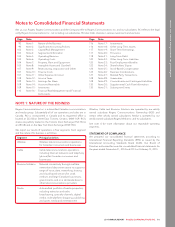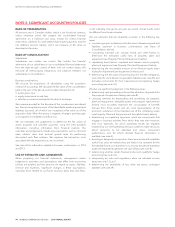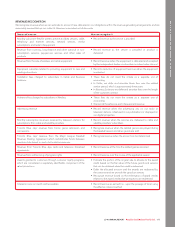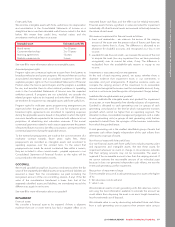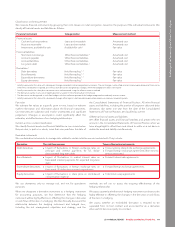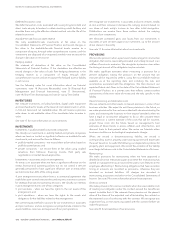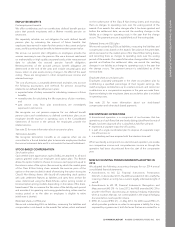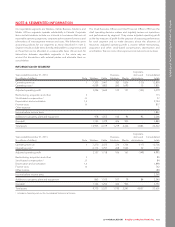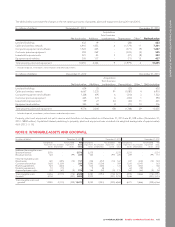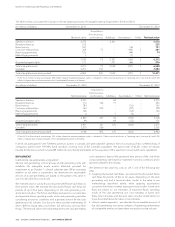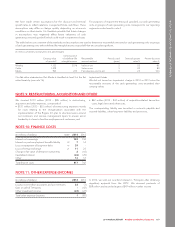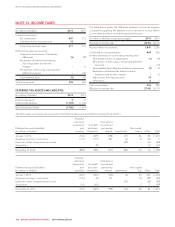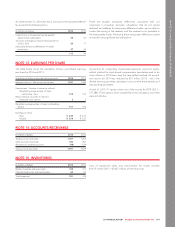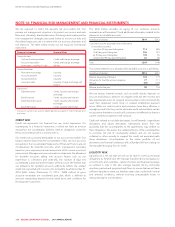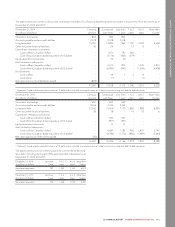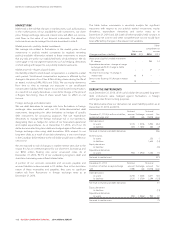Rogers 2014 Annual Report Download - page 106
Download and view the complete annual report
Please find page 106 of the 2014 Rogers annual report below. You can navigate through the pages in the report by either clicking on the pages listed below, or by using the keyword search tool below to find specific information within the annual report.
NOTES TO CONSOLIDATED FINANCIAL STATEMENTS
accordance with IAS 37, Provisions, Contingent Liabilities and
Contingent Assets and those where the timing and amount of the
levy is certain. The Interpretation identifies the obligating event for
the recognition of a liability as the activity that triggers the payment
of the levy in accordance with the relevant legislation. It provides the
following guidance on recognition of a liability to pay levies (i) the
liability is recognized progressively if the obligating event occurs
over a period of time, and (ii) if an obligation is triggered on
reaching a minimum threshold, the liability is recognized when that
minimum threshold is reached.
The accounting pronouncements we adopted in 2014 were made in
accordance with their transitional provisions, which were required to
be applied retrospectively and had no impact on our financial results.
RECENT ACCOUNTING PRONOUNCEMENTS NOT YET
ADOPTED
The IASB has issued new standards and amendments to existing
standards. These changes are not yet adopted as at December 31,
2014, and could have an impact on future periods.
• IFRS 15, Revenue from Contracts with Customers (IFRS 15) – In May
2014, the IASB issued IFRS 15 which supersedes existing standards
and interpretations including IAS 18, Revenue and IFRIC 13,
Customer Loyalty Programmes.
IFRS 15 introduces a single model for recognizing revenue from
contracts with customers with the exception of certain contracts
under other IFRSs such as IAS 17, Leases. The standard requires
revenue to be recognized in a manner that depicts the transfer of
promised goods or services to a customer and at an amount that
reflects the expected consideration receivable in exchange for
transferring those goods or services. This is achieved by applying the
following five steps:
1. Identify the contract with a customer;
2. Identify the performance obligations in the contract;
3. Determine the transaction price;
4. Allocate the transaction price to the performance obligations in
the contract; and
5. Recognize revenue when (or as) the entity satisfies a
performance obligation.
IFRS 15 also provides guidance relating to the treatment of contract
acquisition and contract fulfillment costs.
We expect the application of this new standard will have significant
impacts on our reported results, specifically with regards to the
timing of recognition and classification of revenue, and
the treatment of costs incurred in obtaining customer contracts. The
standard is effective for annual periods beginning on or after
January 1, 2017. We are assessing the impact of this standard on our
consolidated financial statements.
• IFRS 9, Financial Instruments (IFRS 9) – In July 2014, the IASB issued
the final publication of the IFRS 9 standard, superseding the current
IAS 39, Financial Instruments: recognition and measurement
(IAS 39) standard. IFRS 9 includes revised guidance on the
classification and measurement of financial instruments, including a
new expected credit loss model for calculating impairment on
financial assets, and the new general hedge accounting
requirements. It also carries forward the guidance on recognition
and derecognition of financial instruments from IAS 39. The
standard is effective for annual periods beginning on or after
January 1, 2018 with early adoption permitted. We are assessing the
impact of this standard on our consolidated financial statements.
• Amendments to IAS 16, Property, Plant and Equipment and IAS 38,
Intangible Assets – In May 2014, the IASB issued amendments to
these standards to introduce a rebuttable presumption that the use
of revenue-based amortization methods for intangible assets is
inappropriate. The amendment is effective for annual periods
beginning on or after January 1, 2016 with early adoption
permitted. We are assessing the impact of this amendment on our
consolidated financial statements.
• Amendments to IFRS 11, Joint Arrangements – In May 2014, the
IASB issued an amendment to this standard requiring business
combination accounting to be applied to acquisitions of interests in
a joint operation that constitute a business. The amendment is
effective for annual periods beginning on or after January 1, 2016.
We are assessing the impact of these standards on our consolidated
financial statements.
NOTE 3: CAPITAL RISK MANAGEMENT
Our objectives in managing capital are to ensure we have sufficient
liquidity to meet all of our commitments and to execute our business
plan. We define capital that we manage as shareholders’ equity
(including issued capital, share premium, retained earnings, hedging
reserve and available-for-sale financial assets reserve) and
indebtedness (including current portion of our long-term debt, long-
term debt and short-term borrowings).
We manage our capital structure, commitments and maturities and
make adjustments based on general economic conditions, financial
markets and operating risks and our investment and working capital
requirements. To maintain or adjust our capital structure, we may, with
approval from our Board of Directors, issue or repay debt and/or short-
term borrowings, issue shares, repurchase shares, pay dividends or
undertake other activities as deemed appropriate under the
circumstances. The Board of Directors reviews and approves the
annual capital and operating budgets, and any material transactions
that are not part of the ordinary course of business, including
proposals for acquisitions or other major financing transactions,
investments or divestitures.
We monitor debt leverage ratios such as adjusted net debt to adjusted
operating profit as part of the management of liquidity and
shareholders’ return to sustain future development of the business,
conduct valuation-related analyses and make decisions about capital.
The Rogers First Rewards Credit Card program (operated through a
100% owned subsidiary of RCI) is regulated by the Office of the
Superintendent of Financial Institutions, which requires that a minimum
level of regulatory capital be maintained. Rogers was in compliance
with that requirement as at December 31, 2014 and 2013. This
program was launched in the fourth quarter of 2013 and the capital
requirements are not material as at December 31, 2014.
With the exception of Rogers First Rewards Credit Card program, we
are not subject to externally imposed capital requirements. Our overall
strategy for capital risk management has not changed since
December 31, 2013.
102 ROGERS COMMUNICATIONS INC. 2014 ANNUAL REPORT



